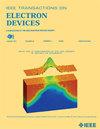铁电在栅极侧注入铁电场效应管内存窗口扩展中的作用
IF 2.9
2区 工程技术
Q2 ENGINEERING, ELECTRICAL & ELECTRONIC
引用次数: 0
摘要
在这项工作中,我们提出了一个全面的实验和建模研究,以阐明铁电(FE)层在增强栅极侧电荷注入的fet的记忆窗口(MW)中的作用。我们将FE对MW的贡献分为残余极化和顶部电荷捕获层(CTL)捕获。研究结果表明:1)FE层通过两种方式扩展MW:一是通过门侧电荷捕获引起的FE极化增强,二是通过它们的超线性${Q} {_{\text {FE}} $ - ${V} {_{\text {FE}}}$关系增强CTL电场并增强电荷捕获;2)极化和CTL捕获的贡献相互增强,导致比FE +介质堆栈或高- ${k} +$ CTL堆栈更大的MW,在这两个堆栈中,只有一个因素是有效的;3)增强的极化增强了通道界面层电场,抑制了电子从通道中脱陷,从而实现了立即的写后读,从而提高了ffet的读吞吐量;4)在CTL上方加入阻塞氧化物层可以进一步增加MW,通过2 nm厚的Al2O3层实现12 v窗口。本文章由计算机程序翻译,如有差异,请以英文原文为准。
Elucidating the Role of Ferroelectric in Memory Window Expansion of Ferroelectric FETs With Gate-Side Injection
In this work, we present a comprehensive experimental and modeling study to clarify the role of the ferroelectric (FE) layer in enhancing the memory window (MW) of FeFETs with gate-side charge injection. We separated the FE contributions to the MW into remnant polarization and top charge trap layer (CTL) trapping. Our findings demonstrate that: 1) FE layer expands the MW in two ways: by enhanced FE polarization induced by gate-side charge trapping into the CTL and through their superlinear ${Q} {_{\text {FE}}}$ – ${V} {_{\text {FE}}}$ relationship that boosts the CTL electric field and enhances charge trapping; 2) the contributions from polarization and CTL trapping mutually reinforce each other, resulting in a larger MW compared to a FE + dielectric stack or a high- ${k} +$ CTL stack, where, in both stacks, only one factor is active; 3) enhanced polarization strengthens the channel interfacial layer electric field, suppressing electron detrapping from the channel and, thus, enabling immediate read-after–write, thereby improving FeFET read throughput; and 4) the MW can be further increased incorporating a blocking oxide layer above the CTL, achieving a 12-V window with a 2-nm-thick Al2O3 layer.
求助全文
通过发布文献求助,成功后即可免费获取论文全文。
去求助
来源期刊

IEEE Transactions on Electron Devices
工程技术-工程:电子与电气
CiteScore
5.80
自引率
16.10%
发文量
937
审稿时长
3.8 months
期刊介绍:
IEEE Transactions on Electron Devices publishes original and significant contributions relating to the theory, modeling, design, performance and reliability of electron and ion integrated circuit devices and interconnects, involving insulators, metals, organic materials, micro-plasmas, semiconductors, quantum-effect structures, vacuum devices, and emerging materials with applications in bioelectronics, biomedical electronics, computation, communications, displays, microelectromechanics, imaging, micro-actuators, nanoelectronics, optoelectronics, photovoltaics, power ICs and micro-sensors. Tutorial and review papers on these subjects are also published and occasional special issues appear to present a collection of papers which treat particular areas in more depth and breadth.
 求助内容:
求助内容: 应助结果提醒方式:
应助结果提醒方式:


